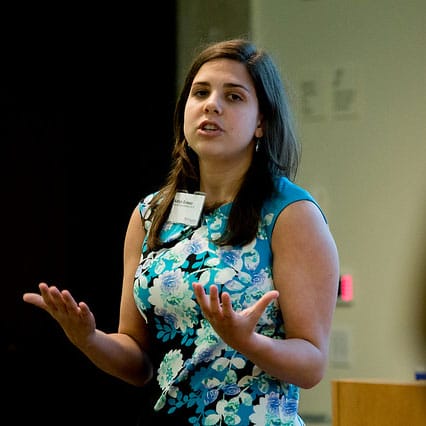
Wharton senior Katlyn Grasso, founder of GenHERation, also presented at the Wharton Seminars for Business Journalists in San Francisco. All photos credited to: The Wharton School Flickr stream.
Nearly 3,000 miles across the country, Wharton is infusing the entrepreneurial spirit of Silicon Valley into educational programming at its San Francisco campus. In June 2014, Wharton welcomed more than 30 journalists from across the nation to participate in its Seminars for Business Journalists, titled “Innovation, Technology and Entrepreneurship.” The session included interactive discussions with Saikat Chaudhuri, ENG’97, W’97, Wharton adjunct associate professor of management and executive director of the Mack Institute for Innovation Management, and Professor David Robertson, Wharton Practice Professor of Operations and Information Management. Although the seminar focused on disruptive innovation at the organizational level through case studies of Kodak and LEGO, I attended the seminar to gain a better understanding of the role journalism plays in advancing innovation and entrepreneurship.
June Bell, an award-winning freelance writer in the San Francisco Bay Area, recognizes that technology has revolutionized the way people report and consume news.

Prof. Saikat Chaudhuri
“As journalists, we’re forced to grapple with rapid-fire innovations in how people access and digest news, whether we want to or not. But that’s good for us and good for the industry. Is it possible to tell stories in 140 characters or less?” she told me. “Should we stop printing newspapers to push our readers online—or will we lose them completely? And the perennial question in our digital age: How do we entice our audience to open their wallets for our work?”
The effect of technology transcends every mode of journalism, including television. The journalism industry is constantly evolving, Pamela Ambler, Host of Talk Finance on KTSF San Francisco, explained to me.
“We have to innovate in the way we produce our work and react to how audiences respond to the product. A story does not reach its full potential without being shared. We have to strive to ensure that stories get told and inspire new ways of providing news and info,” she said.
Austin Cross, a producer at CBS Radio in Los Angeles, views the media as a mechanism for entrepreneurs to evaluate how their products or services are being perceived by the public.

Prof. David Robertson
“For many companies, both large and small, exposure from an established and well-regarded media outlet can provide organizations with their first real feedback from a target audience. This response, whether positive or negative, can provide insight and inspiration that no focus group could supply. Meanwhile, although media coverage offers clear advantages to any company, modern social media platforms also allow companies to present their ideas directly to their customer base,” he said.
After speaking with the journalists, I learned that there is a synergistic relationship between innovation and the media. The ability to convey a compelling story is a skill that is required of both journalists and entrepreneurs to capture society’s interest in their content and businesses. Jaclyn Trop, a freelancer who covered the automotive industry for The New York Times, echoed this finding with her perspective on the seminar: “Innovation doesn’t happen in a vacuum. As Professor Robertson explained, it has to be relevant to an audience and it’s got to have utility. Journalism inspires that conversation and gets the gears churning.”

























